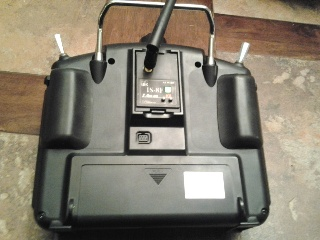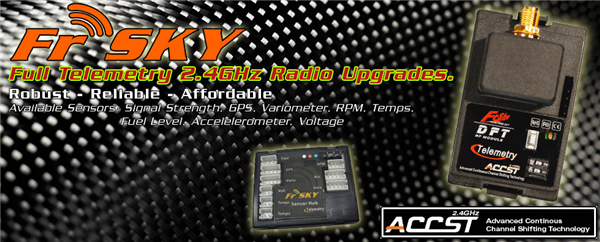| Author |
 Topic Topic  |
|
|
aeajr
477 Posts |
 Posted - 04/08/2012 : 10:28:52 PM Posted - 04/08/2012 : 10:28:52 PM

|
The Economics of Upgrading Your Radio from 72 MHz to 2.4 GHz
A Research Project - Part 1 - Originally written for the Long Island Flyers Newsletter
By Ed Anderson
I am in constant research mode. One of my latest research projects has been to look at the entry or upgrade costs of moving into 2.4 GHz. This article is focused on newer sailplane pilots who have not yet purchased a sailplane radio or club members who are flying on 72 MHz and thinking about moving to 2.4 GHz.
This will be the first in a two article series. This one is going to look at used 72 MHz sailplane radios vs. new 2.4 GHz sailplane radios. Part 2 will be about a new approach to radio systems based on an open source hardware/software approach using the SkyFly TH9X, also marketed as the Turnigy 9X. Watch for that next month.
If you are flying 2 or 3 channel RES gliders or 3-4 channel electric RES gliders, any 6 channel computer radio will serve you well. And you can fly a full house glider or e-glider on that same 6 channel computer radio, but you won�t be able to do all the things that glider pilots want to do with full house six servo gliders or full house e-gliders. For that you need a radio with at least 7 channels and sailplane mixes. A radio like a Spektrum DX7 has 7 channels, but it lacks the sailplane mixing to be called a sailplane radio.
If you are still learning about sailplanes and sailplane radios, this article on the Eastern Soaring League web site might be of interest.
Selecting a sailplane Radio, What to consider
http://www.flyesl.org/forums/topic.asp?TOPIC_ID=223
The sailplane radios I normally recommend include the JR9503 ($550), Futaba 8FG Super ($480), Airtronics SD-10G ($440) or the Hitec Aurora 9 ($400). Each comes with a receiver. Add on receivers cost $70 to $150. Don�t forget that these also include at least a 1 year warranty which you won�t get with a used radio.
There is a large market for used 72 MHz radios that are great sailplane radios. I can't cover them all, but I will look at two that I know to be typical of the market, the JR9303 and the Futaba 9C Super. These will allow me to illustrate the economics of buying a used radio and upgrading to 2.4 GHz. An upgrade to 2.4 is not required but as the trend is to 2.4 that will be the basis of my analysis.
RC computer radios are made up of two components. The part that we think of as the radio is the box with the sticks and dials. It houses the main circuit board which includes a processor that runs the program that displays the menus and translates stick and switch input into signals that are sent to the radio frequency, RF, section of the radio to be transmitted to the receiver in the plane. Some RF systems are one way and some systems are two way. Two way RF systems enable telemetry back to the radio.
Since the need to change channels went away when 2.4 GHz arrived, most new 2.4 GHz radios have the RF section built in so you cannot easily change it. But most 72 MHz sailplane radios were module based so you could change from one 72 MHz channel to another to avoid channel conflict. It is the module based nature of these 72 MHz sailplane radios that will allow us to easily upgrade them to 2.4 GHz to bring them into the modern age of radio control. So let's look at the economics.
The JR 9303 was one of the top competition radios only a few years ago. Looking on the RC Groups radios for sale area we see that the 72 MHz 9303 going for about $225 to $275, often with several 72 MHz receivers. A new JR 9503, including a 2.4 GHz receiver costs about $550.
Let's do the math to buy a radio and put 4 full house gliders into the air.
New JR 9503 ($550 with 1 receiver) and 3 add on AR7010 receivers at $90 each.
$550 + $270 = $820 for a new radio and 4 receivers to put up 4 full house gliders.
Used 9303 + Spektrum 2.4 GHz module/receiver package and 3 add-on AR7010.
$250 + 110 + 270 = $600. A savings of $190
Let's do the same with the Futaba 9C Super. I fly the 9C Super which I have upgraded to Futaba FASST 2.4 GHz using Futaba modules.
Looking at the Futaba line today we see the Futaba 8FG Super would be the new alternative to the used 9C Super.
New Futaba 8FG Super $480 including 1 receiver and 3 add on receivers at $90 each.
$480 + $270 = $750 for a new radio and 4 receivers to put up 4 full house gliders
Used Futaba 9C Super, FASST module/receiver package and 3 receivers at $90 each.
$200 + $200 + 270 = $670 � A saving of $80. Perhaps not enough to justify buying used based on the high cost of the Futaba FASST module/receiver package.
THIRD PARTY 2.4 GHz MODULE SYSTEM
What if we go to a third party 2.4 GHz module and receiver system? There are several available, but research has shown that the FrSky system, available for Futaba, Hitec and JR and others, is rock solid.
Insert Image: 
FrSky also offers an extensive line of telemetry products for their module based system. I have seen many posts by giant scale pilots, glider pilots, gas and glow pilots and electric pilots. They say this system is every bit as good as Futaba�s FASST system, but much less expensive.
The module and receiver package is $40 at HobbyKing and add on receivers are about $30. Since we can put this FrSky module into a JR 9303 or Futaba 9C let's look at the numbers.
JR 9303 + FrSky module/receiver and 3 more receivers.
$250 +$40 + $90 = $380. That is about half the price of the new JR 9503 DSMX and Spektrum receivers and almost 40% lower than a used 9303 using Spektrum DSM2 module and receivers.
We see even better savings when we look at the Futaba set-up.
$200 + $40 + 90 = $330. That is a $420 or about a 55% saving over a new Futaba System and a $340 or 50% saving over the used system.
Note in both the JR and Futaba cases a LOT of the savings comes from the lower cost of the receivers that we can use as a result of using the FrSky module. At a $60 saving per plane, the more planes you put up the more you save.
So, you ask, is FrSky as good as Futaba FASST or Spektrum DSM2? According to RCModelReviews, the answer is yes. In fact the reports suggest that the FrSky system is every bit as good as the Futaba FASST system and is better than the Spektrum/JR DSM2 system that the JR/Spektrum module provides.
The link below goes to a discussion on the Flying Giants forum that includes several posts by XJET. In this case he is talking about the FlySky 9X radio but he is talking about it with the FrSky module system I discuss above. His comments are quote revealing and typical of the reports I have received. BTW, in part two of this series I will be talking about the FlySky 9X radio as an even lower cost sailplane radio option.
http://www.flyinggiants.com/forums/showthread.php?t=62466
Glider pilots talking about FrSky for a Supra
http://www.rcgroups.com/forums/showthread.php?t=1552991
RFModule Shoot-out
http://www.rcmodelreviews.com/2.4ghzshootout.shtml
More pilot reports on FrSky � Airtronics, Futaba, JR, ACE and others
http://www.rcuniverse.com/forum/m_10935796/tm.htm
http://www.rcuniverse.com/forum/m_9994819/tm.htm
Insert Image: 
image courtsey of www.alofthobbies.com - US based supplier of the FrSky system.
Of course, if you read the forums you will find negative posts too. But you can say the same for JR, Futaba, Hitec, Airtronics or Spektrum. Based on my research of the major brands and the FrSky system, the positive reports far outweigh the negatives
The FrSky receivers are about 1/4 to 1/2 the price of the comparable Hitec, Spektrum, Futaba and JR receivers. When you take this into account the economics of upgrading a 72 MHz module base radio to 2.4 GHz looks very attractive. And there is a DYI kit to upgrade radios that are not module based.
WHAT DID YOU DO ED?
You might ask why I did not go to the FrSky system when I moved my Futaba 9C Supers from 72 MHz to 2.4 GHz. The answer is that I did not know about the robust nature and rave reviews that FrSky was getting at the time that I bought the Futaba FASST system. I learned about the FrSky system while doing the research for the second article in this series. By then I had already purchased two Futaba FASST modules and four 7 channel receivers at a cost of $570.
If I had purchased FrSky to upgrade my radios I would have only spent $140 for the same two modules and four 8 channel receivers. It was this discovery that leads me to write this article so that you could make a more informed decision than I did. But I will note that I am very happy with the Futaba FASST system. It works great. However I have already purchased one Orange (relabeled FrSky) FASST compatible receiver and plan to buy a couple of FrSky FASST compatible receivers as I continue to covert the fleet to FASST.
So, you have to ask yourself if you would be comfortable trusting your glider to a third party 2.4 GHz system. Only you can make that decision. Many pilots have put Spektrum 2.4 GHz modules in their non-Spektrum radios. I have a Spektrum module for my Futaba 9C Super. Hitec markets their Spectra 2.4 modules for Futaba and JR radios. And many Futaba pilots have used Hitec Spectra 72 MHz synth modules in their 72 MHz radios. Using third party modules is not new. There are probably a dozen makers of 2.4 GHz modules and conversion kits for our radios.
I have provided references from reviews and pilot discussions about the FrSky system. I have plenty more. But in the end, you have to make the decision. Every launch is an act of faith and every landing a moment of relief. What makes you comfortable is up to you.
I will close this article on this note, whether you fly JR, Futaba, Spektrum, Hitec, Airtronics, FrSky or something else, no one will guarantee you won't have a problem. And none of them will reimburse you for a crashed plane. So, you fly at your own risk no matter which system you use.
Clear Skies and Safe Flying!
Reference links
www.alofthobbies.com - USA FrSky Dealer
www.HobbyKing.com - HK FrSky Dealer
|
Best regards,
Ed Anderson
Long Island Silent Flyers
|
|
| |
 Topic Topic  |
|
|
|

